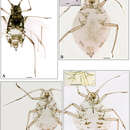Description
provided by Zookeys
Apterous viviparous female(Fig. 5B). Colour in life unknown. Antennae, rostrum, legs, siphunculi, genital plate and cauda yellowish. Frontal tubercles low. Mesosternal mammariform processes low, rough and pale, sometimes inconspicuous. Dorsum of thorax and abdomen without segmental sclerites; intersegmental and spiracular sclerites inconspicuous. The characteristic spinules on postsiphuncular area and tergum of abdominal segments 7 and 8 are dispersed and delicate. Siphunculi short, slightly swollen and densely covered with scales. Cauda short triangular, with broad basis. Metric and meristic features in Table 4.
Metric and meristic features of apterous viviparous females of Aphidura pakistanensis sp. n., Aphidura graeca sp. n., Aphidura urmiensis sp. n., and Aphidura iranensis sp. n.; n, number of measured specimens.
Aphidura pakistanensis Aphidura graeca Aphidura urmiensis Aphidura iranensis n = 4 n = 1 n = 20 n = 6 Body [mm] 1.725–1.850 1.838 1.900–2.125 1.100–1.300 Antenna [mm] 1.053–1.655 1.670 1.333–1.755 1.005–1.210 Antenna / Body [times] 0.59–0.89 0.91 0.67–0.84 0.80–1.08 Ant. segm. III [mm] 0.32–0.49 0.37–0.40 0.39–0.52 0.30–4.33 Ant. segm. IV [mm] 0.15–0.26 0.26–0.26 0.21–0.34 0.16–0.20 Ant. segm. V [mm] 0.14–0.20 0.19–0.2 0.15–0.21 0.14–0.16 Ant. segm. VI base [mm] 0.11–0.14 0.14 0.09–0.12 0.08–0.10 Ant. segm. VI [mm] 0.22–0.31 0.56 0.30–0.44 0.31–0.35 Ant. segm. VI processus terminalis/ Ant. segm. III [times] 0.63–0.80 1.51 0.65–0.95 0.96–1.13 Ant. segm. VI processus terminalis/ base [times] 2.00–2.39 4.00 2.78–4.00 3.18–4.53 Ultimate rostral segm. [mm] 0.10–0.12 0.13 0.13–0.15 0.10–0.11 Ultimate rostral segm. / its basal width [times] 1.10–2.00 1.86 2.36–2.64 2.20–2.50 Ultimate rostral segm. / Ant. segm. VI base [times] 0.85–1.00 0.93 1.17–1.61 1.08–1.26 Hind femur [mm] 0.39–0.52 0.55–0.54 0.48–0.59 0.33–0.37 Hind tibia [mm] 0.73–0.95 0.92–0.92 0.86–1.05 0.63–0.70 Hind tibia / Body [times] 0.41–0.51 0.50–0.50 0.44–0.52 0.49–0.62 Hind tarsus, 2nd segm. [mm] 0.11–0.13 0.14–0.13 0.10–0.12 0.09–0.10 Hind tarsus, 2nd segm. / Ultimate rostral segm. [times] 1.05–1.20 1.04–1.00 0.69–0.81 0.84–0.95 Abdominal Marginal papillae [number] 0 0 0 (0)2–4 Siphunculus [mm] 0.17–0.20 0.39 0.47–0.58 0.26–0.31 Siphundulus / Body [times] 0.09–0.11 0.21 0.23–0.29 0.21–0.27 Siphunculus / Ant. segm. III [times] 0.41–0.56 1.04 1.11–1.36 0.79–1.02 Siphunculus / its basal width [times] 2.62–3.18 5.50 4.14–5.50 3.86–6.56 Siphuncular widths, maximal / basal [times] 0.69–0.82 0.79 0.44–0.67 0.61–0.89 Siphuncular widths, maximal / minimal [times] 1.00–1.06 1.38 1.00–1.00 1.06–1.13 Siphuncular minimal width / Hind tibia, diameter at middle [times] 1.42–1.50 0.94 1.24–1.65 1.25–1.89 Cauda [mm] 0.11–0.14 0.23 0.18–0.24 0.11–0.12 Cauda / Siphunculus [times] 0.55–0.82 0.60 0.33–0.45 0.37–0.40 Cauda / its basal width [times] 0.71-0.00 1.80 1.20–1.60 0.92–1.05 Setae on … … Frons [μm] 8–10 9 33–45 5–10 … Frons / b. d. Ant. segm. III [times] 0.38–0.44 0.39 1.40–2.12 0.25–0.67 … Vertex [μm] 8–10 8 25–40 8 … Vertex / b. d. Ant. segm. III [times] 0.38–0.57 0.3 1.1–1.9 0.4–0.5 … Ant. segm. III [μm] 8–10 10 14–21 5–8 … Ant. segm III / b. d. Ant. segm. III [times] 0.4–0.6 0.4 0.6–0.9 0.3–0.5 … Ultimate rostral segm. [number] 5–7 13 10–15 8–11 … Hind femur, dorsal [μm] 10–13 5 13–20 3–5 … Hind femur, ventral [μm] 13–18 13 25–40 8–10 … Hind tibia, dorsal, at middle [μm] 20–25 18 25–38 15–23 … Hind tibia, dorsal / Tibial diameter (at middle) [times] 0.7–0.8 0.41 0.6–0.9 0.6–0. 9 … Hind tarsus, first segm. [number] 2–3 2–3 2–3 2–3 … Abdominal segm.s 2-4 [μm] 10–10 3 15–23 4–8 … Abdominal segm.s 2-4 / b. d. Ant. segm. III [times] 0.4–0.6 0.11 0.7–1.1 0.2–0.4 … Abdominal segm. 8 [μm] 20–25 10 23–38 8–15 … Abdominal segm. 8 / b. d. Ant. segm. III [times] 1.0–1.4 0.44 1.0–1.8 0.4–0.9 … Abdominal segm. 8 [number] 4–5 2 3–5 4 … Ventro-abdominal [μm] 20–38 28 30–45 11–16 … Genital plate, discal [number] 2 2 2 2 … Genital plate, marginal [number] 10–14 13 9–18 7–10 … Cauda [number] 6–8 7 9–14 6–6
NOTE. Used abbreviations: Ant., Antennal; b. d., basal diameter; n, number of measured specimens; segm., segment.
- license
- cc-by-3.0
- copyright
- Juan-Manuel Nieto Nafría, Milagros-Pilar Mier Durante, Georges Remaudière
- bibliographic citation
- Nieto Nafría J, Mier Durante M, Remaudière G (2013) The genus Aphidura (Hemiptera, Aphididae) in the collection of the Muséum national d’Histoire naturelle of Paris, with six new species ZooKeys 318: 1–33
- author
- Juan-Manuel Nieto Nafría
- author
- Milagros-Pilar Mier Durante
- author
- Georges Remaudière

